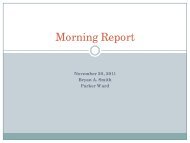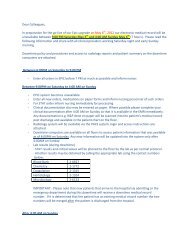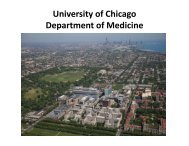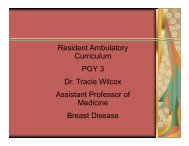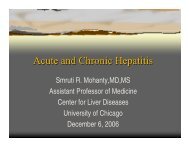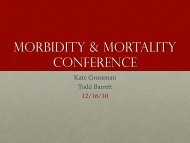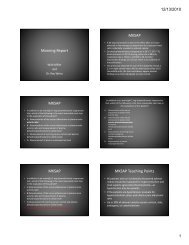Question 1 (MKSAP Q4)
Question 1 (MKSAP Q4)
Question 1 (MKSAP Q4)
You also want an ePaper? Increase the reach of your titles
YUMPU automatically turns print PDFs into web optimized ePapers that Google loves.
Board Review<br />
Malignant a g a Hematology e a o ogy<br />
Nitin Jain<br />
Fellow Fellow, HemOnc<br />
April 18, 18 2011
<strong>Question</strong> 1 (<strong>MKSAP</strong> <strong>Q4</strong>)<br />
A 67-year-old man comes for a routine physical examination. The patient has<br />
hypertension treated with hydrochlorothiazide. On examination, temperature<br />
is normal normal, blood pressure is 140/85 mm Hg Hg, pulse rate is 88/min 88/min, and<br />
respiration rate is 16/min. The patient has a ruddy complexion. There is no<br />
jugular venous distention. Cardiopulmonary examination is normal. The<br />
spleen tip is palpable just below the left costal margin.<br />
Laboratory studies<br />
Hematocrit 61% Leukocyte count 11.2 K<br />
Platelet count 405 K Erythropoietin 10 mU/mL<br />
Arterial oxygen saturation 96%<br />
C Cytogenetic ( (correct is Molecular) ) studies show a JAK2 mutation<br />
Which of the following is the most appropriate treatment?<br />
A Therapeutic phlebotomy<br />
A. Therapeutic phlebotomy<br />
B. Therapeutic phlebotomy plus anagrelide<br />
C. Therapeutic phlebotomy plus aspirin<br />
D. Therapeutic phlebotomy plus hydroxyurea
Myeloproliferative neoplasms (MPN)<br />
2008 WHO classification: MPD (Myeloproliferative disorder) renamed as MPN<br />
Chronic myelogenous leukemia<br />
Polycythemia vera<br />
Essential thrombocythemia<br />
Primary myelofibrosis<br />
Chronic neutrophilic leukemia<br />
Chronic eosinophilic leukemia<br />
Hypereosinophilic syndrome<br />
Mast cell disease<br />
MPNs, unclassifiable<br />
.<br />
Classic C ass c MPN
Polycythemia vera<br />
Overproduction of erythrocytes (ONLY myeloproliferative disorder<br />
with increased Hb)<br />
WBC cells and platelets can also be increased<br />
Signs and symptoms<br />
Headache<br />
Pruritus (especially with hot bath)<br />
Erythromelalgia (burning pain in feet/hands with warmth and<br />
erythema) y )<br />
Thrombotic disorders most serious issue (TIA, MI ,Stroke, DVT)<br />
Budd-Chiari syndrome: 50% have underlying PV<br />
Diagnosis: Rule out secondary causes<br />
Smoking, COPD, Sleep Apnea, morbid obesity, high altitude<br />
Renal cell carcinoma, carcinoma Hepatocellualr carcinoma carcinoma, uterine fibroids
Osler (1903) PVSG (1967) WHO (2001) WHO (2008)<br />
Erythrocytosis<br />
Cyanosis<br />
Splenomegaly<br />
<br />
<br />
Major<br />
A-criteria<br />
Major criteria<br />
TABLE # 4: Increased Diagnostic red criteria cell mass for polycythemia # Elevated vera over red different cell mass time or periods # Hb >18.5 (men) or<br />
# Normal oxygen saturation Hb >18.5 (men) or >16.5 Hb >16.5 (women)<br />
# Splenomegaly<br />
(women)<br />
# No cause of secondary # Presence of JAK2<br />
Minor<br />
erythrocytosis<br />
mutation<br />
# Platelet count > 400 K # Splenomegaly<br />
# WBC > 12 K<br />
# clonal genetic<br />
Minor criteria<br />
# LAP score<br />
# Vitamin B12<br />
abnormality<br />
# Endogenous g erythroid y<br />
colony formation<br />
# Bone marrow biopsy<br />
showing gp panmyelosis y with<br />
erythroid, granulocytic<br />
and megakaryocytic<br />
Diagnosis: All 3 major or first B-criteria<br />
proliferation<br />
2 major and any 2 minor # Platelet count > 400 K # Low serum epo<br />
# WBC > 12 K<br />
# Endogenous erythroid<br />
# Bone B marrow biopsy bi<br />
showing panmyelosis with<br />
colony l formation f ti i in vitro it<br />
erythroid and<br />
Diagnosis: Both major<br />
megakaryocytic<br />
criteria with 1 minor or<br />
proliferation<br />
first major with any 2<br />
# Low serum erythropoietin minor criteria<br />
Diagnosis: First 2 A-criteria<br />
with either any other Acriteria<br />
or 2 B-criteria
First described in 2005<br />
~ 100% ofPV of PV<br />
JAK2 mutation<br />
50% ET (essential thrombocythemia)<br />
50% PMF (primary myelofibrosis)<br />
Presence of JAK2 mutation<br />
establishes Dx of MPN<br />
could be PV / ET / PMF<br />
Negative JAK2<br />
rules out PV<br />
could be ET/PMF or anything else
PV treatment<br />
Phlebotomy all patients<br />
Goal Hct
<strong>Question</strong> 1 (<strong>MKSAP</strong> <strong>Q4</strong>)<br />
A 67-year-old man comes for a routine physical examination. The patient has<br />
hypertension treated with hydrochlorothiazide. On examination, temperature<br />
is normal normal, blood pressure is 140/85 mm Hg Hg, pulse rate is 88/min 88/min, and<br />
respiration rate is 16/min. The patient has a ruddy complexion. There is no<br />
jugular venous distention. Cardiopulmonary examination is normal. The<br />
spleen tip is palpable just below the left costal margin.<br />
Laboratory studies<br />
Hematocrit 61% Leukocyte count 11.2 K<br />
Platelet count 405 K Erythropoietin 10 mU/mL<br />
Arterial oxygen saturation 96%<br />
C Cytogenetic ( (correct is Molecular) ) studies show a JAK2 mutation<br />
Which of the following is the most appropriate treatment?<br />
A Therapeutic phlebotomy<br />
A. Therapeutic phlebotomy<br />
B. Therapeutic phlebotomy plus anagrelide<br />
C. Therapeutic phlebotomy plus aspirin<br />
D. Therapeutic phlebotomy plus hydroxyurea
<strong>Question</strong> 2 (<strong>MKSAP</strong> Q32)<br />
A 55-year-old man has a 1-year history of fatigue, daytime hypersomnolence,<br />
and frequent nighttime awakenings. The patient has hypertension and a 48pack-year<br />
smoking history. His only medication is lisinopril.<br />
On physical examination, temperature is normal, blood pressure is 135/85 mm<br />
Hg, pulse rate is 88/min, and respiration rate is 28/min. BMI is 35. Examination<br />
is otherwise unremarkable.<br />
Laboratory studies: Hematocrit 59%, WBC 5.7 K, Platelet count 345 K, Epo 30<br />
mU/mL<br />
Arterial oxygen saturation (on ambient air) 95%<br />
Hematocrit measurements prior to 5 years ago were all normal<br />
Cytogenetic (correct is Molecular) studies are negative for the JAK2 gene<br />
mutation<br />
Which of the following g is the most likely y cause of the patient’s elevated<br />
hematocrit?<br />
A. Relative polycythemia<br />
B. High-oxygen–affinity hemoglobin<br />
CC. PPolycythemia l th i vera<br />
D. Secondary polycythemia<br />
Needs pulse ox with exertion, sleep study
<strong>Question</strong> 3 (<strong>MKSAP</strong> Q18)<br />
A 54-year-old man is evaluated for increased lethargy and vague abdominal<br />
symptoms of 2 weeks weeks’ duration duration. His medical and family histories are<br />
noncontributory. He does not smoke and takes no medications. Vitals stable.<br />
Arterial oxygen saturation is 99% on ambient air. There is no clubbing or<br />
evidence of cyanosis. y Cardiopulmonary y examination is normal. The abdomen<br />
is soft, and there is no hepatosplenomegaly.<br />
Lab studies: Hemoglobin 20.2 g/dL, Platelet count 312, WBC 8.2 k/µL<br />
Erythropoietin 35 mU/mL<br />
Which of the following is the most appropriate next diagnostic test?<br />
A. Ultrasound of the abdomen<br />
B. Echocardiogram<br />
C. JAK2 mutation analysis<br />
DD. Erythrocyte mass study
<strong>Question</strong> 4 (<strong>MKSAP</strong> Q21)<br />
A 42-year-old woman who is scheduled to undergo a hysterectomy for<br />
endometrial carcinoma comes for a preoperative evaluation. At the time of<br />
her initial evaluation, , she was also discovered to have thrombocytosis. y In<br />
addition to menorrhagia, the patient recently developed epistaxis and easy<br />
bruising. Her only medications are an oral contraceptive agent and an iron<br />
supplement.<br />
EExamination i ti iis normal. l NNo petechiae, t hi ecchymoses, h or splenomegaly.<br />
l l<br />
Laboratory studies: Hemoglobin 11.3, WBC 4.6, platelet count 1,500 K<br />
Platelet function studies: Abnormal platelet aggregation<br />
Cytogenetic (correct is Molecular) studies reveal a JAK2 mutation<br />
Bone marrow examination: Hypercellular marrow with increased<br />
megakaryocytes in clusters.<br />
Which of the following is the most appropriate treatment?<br />
Anagrelide beginning 2 days preoperatively<br />
Hydroxyurea beginning the night after surgery<br />
Low-dose aspirin postoperatively<br />
Platelet apheresis p ppreoperatively p y and hydroxyurea y y ppostoperatively p y
Essential thrombocythemia<br />
2008 WHO criteria for diagnosis g<br />
Sustained platelet count ≥ 450 K<br />
Bone marrow biopsy showing proliferation of megakaryocytes<br />
Not meeting criteria for others MPNs<br />
Demonstration of JAK2 mutation or other clonal markers (no evidence<br />
for reactive thrombocytosis)<br />
Diagnosis of ET requires meeting all 4 criteria<br />
Important to rule out secondary causes:<br />
Iron deficiency deficiency, post post-op op state, state acute inflammatory states<br />
DOES NOT increase thrombosis risk irrespective of degree of elevation
Essential thrombocythemia<br />
Thrombosis main risk<br />
Paradoxical bleeding when platelets >1 million<br />
(some say >1.5 million)<br />
Acquired vWF deficiency<br />
Treatment:<br />
ASA ffor all ll unless l bl bleeding di or platelets l l >1.5 1 5 M<br />
Hydroxyurea vs. anagrelide<br />
UUsed d if age >60 60 / previous i th thrombosis b i<br />
Hydroxyurea preferred over anagrelide (NEJM 2006)<br />
IInterferon t f for f pregnant t patients<br />
ti t
<strong>Question</strong> 5 (<strong>MKSAP</strong> Q27)<br />
A 77-year-old man has a 1-year history of increasing fatigue. He has not seen<br />
a physician p y for at least 3 yyears. Medical and family y histories are<br />
unremarkable, and he takes no medications.<br />
Vitals stable. Cardiopulmonary examination is normal. The spleen is palpable<br />
6 cm below the left costal margin.<br />
Laboratory studies: Hemoglobin 77.6 6 g/dL g/dL, WBC 11 11.2 2 KK, Platelet 104 K<br />
Haptoglobin Elevated, Direct Coombs Negative<br />
A bone marrow aspiration p reveals a “dry y tap.” p<br />
A peripheral blood smear and bone marrow<br />
biopsy are shown<br />
CCytogenetics: t ti NNegative ti Phil Philadelphia d l hi chromosome<br />
h<br />
Which of the following is the most likely diagnosis?<br />
A. Aplastic anemia<br />
B. Chronic myeloid leukemia<br />
C. Myelofibrosis<br />
D. Pure red cell aplasia
Normal megakaryocyte<br />
Myelofibrosis<br />
Normal megakaryocyte
Myelofibrosis<br />
Clonal proliferation of abnormal stromal cells that release fibrosispromoting<br />
p g cytokines y in the bone marrow.<br />
Peripheral blood smear: classic leukoerythroblastic picture of<br />
immature granulocytes, nucleated RBCs, dysmorphic<br />
erythrocytes th t (tear-drop (t d cells) ll )<br />
Prefibrotic stage: Leukocytosis, thrombocytosis<br />
Fibrotic stage: pancytopenia<br />
Splenomegaly and hepatomegaly<br />
Bone marrow: Hypercellularity with dysmorphic megakaryocytes<br />
and fibrosis<br />
Main risk: transformation to AML<br />
Median survival is 3 to 5 years
2008 WHO criteria for diagnosis of PMF
No real good treatment<br />
Myelofibrosis<br />
Conservative management: Epo, G-CSF, PRBC and<br />
platelet p transfusion<br />
Allogeneic stem cell transplant: only curative approach<br />
50% JAK2 mutation positive<br />
• Many y<br />
JAK2 inhibitors in clinical trials
Blood counts in different MPNs<br />
Hb WBC Plt JAK2<br />
PV 100% patients<br />
ET<br />
50% patients<br />
Normal<br />
Pre-fibrotic Pre fibrotic<br />
50% patients<br />
myelofibrosis Normal<br />
CML<br />
Normal<br />
JAK2 negative,<br />
BCR-ABL<br />
positive
<strong>Question</strong> 6 (<strong>MKSAP</strong> Q15)<br />
A 78-year-old woman has a 3-month history of increasing fatigue. She has no<br />
other medical problems and does not take any medications. Vitals normal. The<br />
patient appears pale pale. Examination is unremarkable<br />
unremarkable.<br />
Laboratory studies:<br />
Hemoglobin 7.8 g/dL, Leukocyte count 2.8, ANC 1.2, Platelet count 560<br />
Erythropoietin 600 mU/mL<br />
Bone marrow examination shows hypercellular marrow with erythroid hyperplasia<br />
and dysplasia of the erythroid and granulocyte series. Megakaryocytes are<br />
increased with many hypolobulated cells cells. Iron stores are normal normal. Cytogenetic<br />
studies show deletion of the long arm of chromosome 5 [del(5q-)].<br />
Which of the following is the most appropriate treatment?<br />
AA. AAzacitidine itidi<br />
B. Danazol<br />
C. Lenalidomide<br />
D. Granulocyte colony colony-stimulating stimulating factor and recombinant erythropoietin
5q- 5q MDS<br />
Subtype of MDS with interstitial deletion of 5q<br />
Classically seen in older women<br />
Anemia and thromobocytosis: hallmark<br />
Neutropenia less common<br />
Better prognosis (median ssurvival r i al in one st study d 66.5 5 yrs rs<br />
compared to 2 yrs for other chromosomal abnormalities)<br />
Rx – lenalidomide (Revlimid) – 2 nd generation thalidomide
<strong>Question</strong> 7 (<strong>MKSAP</strong> Q28)<br />
A 25-year-old man is evaluated for the recent onset of fever, fatigue, dyspnea, easy<br />
bruising, and bleeding gums. On physical examination, temperature is 38.8 °C<br />
(101 (101.8 8 °F) °F), BP is 105/60 mm Hg Hg, pulse 120/min 120/min, and RR is 24/min 24/min. Cervical and<br />
axillary lymphadenopathy is noted. Cardiopulmonary examination is normal. The<br />
liver edge and spleen tip are palpable. Laboratory studies: Hemoglobin 8.5 g/dL,<br />
WBC 104 K, ANC 0.6, platelet 17 K, LDH 2200, Uric acid 11.5 mg/dL<br />
CXR: mediastinal mass. Bone marrow: Hypercellular marrow that is replaced with<br />
large blasts containing prominent nucleoli and abundant basophilic cytoplasm. The<br />
blasts do not contain Auer rods. Sudan black and myeloperoxidase y p stains are<br />
negative; periodic acid-Schiff stain is positive. Blasts are also positive for terminal<br />
deoxynucleotidyl transferase (TdT). Immunophenotyping shows CD2, CD3, CD7,<br />
and CD38. BCR/ABL translocation is absent.<br />
Which of the following is the most likely diagnosis?<br />
A. Acute lymphoblastic leukemia<br />
B. Acute myeloid leukemia<br />
CC. Chronic lymphocytic leukemia<br />
D. Hodgkin lymphoma
Acute lymphoblastic leukemia (ALL)<br />
Proliferation of immature lymphoblasts<br />
Constitutes 20% of acute leukemias in adults<br />
Present with lymphocytosis, y p y , neutropenia, p , anemia, , and<br />
thrombocytopenia<br />
Lymphadenopathy and hepatosplenomegaly common<br />
Central nervous system involvement seen (need for LP)<br />
Bone marrow: increased lymphoblasts (Flow cytometry<br />
important)
Treatment<br />
Acute lymphoblastic leukemia (ALL)<br />
Induction: prednisone, vincristine, anthracyclines,<br />
L-asparaginase, 6-mercaptopurine, and high-<br />
dose cytarabine<br />
Consolidation: Variety of drugs similar to Induction<br />
Maintenance: 6-mercaptopurine and methotrexate<br />
Central nervous system prophylaxis: Intrathecal chemotherapy<br />
Philadelphia chromosome positive ALL<br />
Add imatinib/dasatinib to above chemo
<strong>Question</strong> 8 (<strong>MKSAP</strong> <strong>Q4</strong>0)<br />
A 57-year-old woman is brought to the emergency department because of<br />
fever and shaking chills of 8 hours’ duration. The patient has a 1-year history<br />
of myelodysplastic syndrome treated with azacitidine azacitidine. On physical<br />
examination, temperature is 39.2 °C (102.6 °F), BP 100/70 mm Hg, pulse<br />
110/min, and respiration rate is 20/min. Examination is unremarkable. There is<br />
no rash, lymphadenopathy, costovertebral angle tenderness, abdominal<br />
tenderness, or splenomegaly.<br />
Laboratory studies: Hemoglobin 10.6 g/dL<br />
WBC 33.6K, 33 6K Platelet 88<br />
Chest radiograph is normal.<br />
A peripheral blood smear is shown.<br />
Wh What t is i the th likely lik l di diagnosis? i ?<br />
A. Acute lymphoblastic leukemia<br />
B. Acute myeloid leukemia<br />
C. Acute promyelocytic leukemia<br />
D. Chronic myeloid leukemia
Acute myelogenous leukemia<br />
Proliferation of immature myeloblasts<br />
By definition: ≥ 20% blasts in bone marrow<br />
Auer rods clinches the Dx<br />
NOTE NOTE:
Treatment of AML<br />
Acute myelogenous leukemia<br />
Induction: Classically 7+3<br />
7 days of cytarabine and 3 days of idarubicin<br />
At UofC: High dose cytarabine+ Mitoxantrone<br />
Consolidation: high dose cytarabine or many other<br />
regimens i<br />
Unlike ALL, maintenance treatment is not standard<br />
(though many trials underway)
<strong>Question</strong> 9 (<strong>MKSAP</strong> Q34)<br />
An asymptomatic 35-year-old man comes for a routine annual examination.<br />
Medical and family y histories are unremarkable. Vitals and pphysical y examination<br />
normal.<br />
Laboratory studies: Hemoglobin 9.1 g/dL, WBC 2.1, Platelet count 135<br />
LDH 890 U/L U/L, Uric acid 11 11.6 6 mg/dL<br />
Peripheral blood smear: Circulating blasts and promyelocytes<br />
Bone marrow: Hypercellular marrow with 80% myeloblasts and promyelocytes.<br />
Cytogenetic y g studies reveal translocation of chromosomes 15 and 17 [ [t(15;17)]. ( ; )]<br />
In addition to hydration and allopurinol, which of the following is the most<br />
appropriate management at this time?<br />
AA. BBroad-spectrum d t antibiotics tibi ti<br />
B. Chemotherapy<br />
C. Chemotherapy plus all-trans-retinoic acid<br />
DD. HLA typing
Acute promyelocytic leukemia<br />
AML M3 by FAB<br />
Increased number of myeloblasts and promyelocytes<br />
Presence of t(15;17) leading to PML/RARα fusion gene<br />
Besides pancytopenia, DIC main feature (watch bleeding, DIC<br />
panel)<br />
Treatment: all-trans-retinoic acid (ATRA) ( )<br />
Arsenic trioxide<br />
Standard chemotherapy<br />
Some protocols use only ATRA and arsenic (no chemotherapy at all)<br />
ATRA syndrome (Differentiation syndrome)<br />
develops while on ATRA or arsenic<br />
DDyspnea, spnea pulmonary p lmonar infiltrates, infiltrates fe fever er<br />
Stop drug, start steroids
<strong>Question</strong> 10 (<strong>MKSAP</strong> Q8)<br />
A 58-year-old man is evaluated for increasing fatigue of 2 months’<br />
duration duration. Vitals stable stable. There is no lymphadenopathy lymphadenopathy. The spleen is<br />
palpable 4 cm below the left costal margin.<br />
Laboratory studies: Hemoglobin 12.1 g/dL, WBC 55.2 K, Platelet 105 K<br />
A peripheral blood smear shows an increased number of granulocytic cells<br />
in all phases of development but no Auer rods in the blasts.<br />
Bone marrow examination shows hypercellular marrow (80% cellularity)<br />
with marked granulocytic hyperplasia, a left shift in the granulocytes, and<br />
3% myeloblasts myeloblasts. Cytogenetic testing reveals a BCR/ABL translocation<br />
translocation.<br />
Which of the following is the most appropriate next step in managing this<br />
patient?<br />
A. Administration of imatinib<br />
B. HLA typing of the patient and his sister<br />
C. Leukapheresis<br />
DD. Observation with monthly follow-up follow up office visits
Chronic myelogenous leukemia<br />
Characterized by translocation 9;22<br />
Leads to juxtaposition of BCR on chr 22 to ABL on chr 9<br />
(BCR-ABL)<br />
RRx – tyrosine i ki kinase iinhibitors hibi<br />
• First line: Imatinib<br />
First line: Imatinib<br />
• Second line: Dasatinib, Nilotinib
<strong>Question</strong> 11 (<strong>MKSAP</strong> Q91)<br />
A 75-year-old woman with chronic lymphocytic leukemia who was previously<br />
asymptomatic on no therapy undergoes follow-up evaluation for community-acquired<br />
pneumonia for which she was hospitalized hospitalized. The patient completed a course of antibiotic<br />
therapy and currently feels well. She reports no fevers, chills, night sweats, weight loss,<br />
abdominal pain, or new lymphadenopathy, and her pulmonary symptoms have resolved.<br />
Medical history is significant for a previous episode of pneumonia for which she was<br />
hospitalized within the past year year.<br />
Exam is normal other than splenomegaly<br />
Laboratory studies: Hemoglobin 11 g/dL, WBC 24 K, with 80% mature-appearing<br />
lymphocytes, y p y , Platelet count 120 K<br />
IgG: 500 mg/dL<br />
Which of the following is the most appropriate next step in management?<br />
A. Intravenous immune globulin<br />
B. Prophylactic trimethoprim-sulfamethoxazole<br />
CC. Splenectomy<br />
D. Repeat blood counts in 1 month
<strong>Question</strong> 12 (<strong>MKSAP</strong> <strong>Q4</strong>9 CVS)<br />
A 31-year-old woman is evaluated for painless, bilateral lower extremity edema of 4<br />
weeks’ duration. She denies chest pain, dyspnea, orthopnea, and paroxysmal<br />
nocturnal dyspnea dyspnea. She has hypertension hypertension, which has been treated for 2 years with<br />
hydrochlorothiazide. At age 5 years, she had acute lymphoblastic leukemia, which was<br />
treated with vincristine, doxorubicin, and dexamethasone. She is currently on no<br />
medications other than hydrochlorothiazide.<br />
Her blood pressure p is 138/92 mm Hg, g ppulse is 90/min, and respiration p rate is 18/min.<br />
Her BMI is 27. Her estimated central venous pressure is 10 cm H2O. Cardiac<br />
examination reveals a nondisplaced apical impulse, normal heart sounds, and no<br />
murmurs or extracardiac sounds. Pulmonary examination is normal. There is bilateral<br />
lower extremity edema to the knees. Laboratory results include normal levels of<br />
sodium, potassium, p blood urea nitrogen, g and creatinine. Urinalysis y is normal and there<br />
is no evidence of proteinuria.<br />
Electrocardiogram demonstrates sinus rhythm (88/min) and left bundle branch block.<br />
Which of the following is the most appropriate management for this patient?<br />
Which of the following is the most appropriate management for this patient?<br />
A. Adenosine nuclear perfusion imaging study<br />
B. Bilateral lower extremity venous duplex ultrasound<br />
C. Change hydrochlorothiazide to furosemide<br />
D. Transthoracic echocardiography
Hyperleukocytosis and leukostasis<br />
Hyperleukocytosis: Total leukemic cell count > 50K or<br />
100K.<br />
• Seen in AML, ALL, CML, CLL<br />
Leukostasis: seen only in AML<br />
• Need myeloid blasts to clog the arteries<br />
Patient with CLL with WBC count 150K<br />
• no concern for leukostasis<br />
• llymphocytes h t are small ll and d easily il pass th through h th the<br />
blood vessels
Thank you!<br />
And<br />
All the Best



